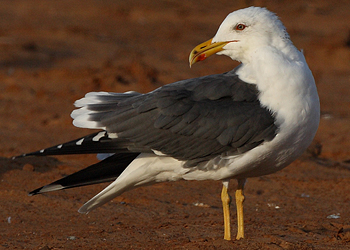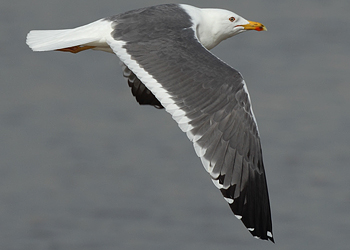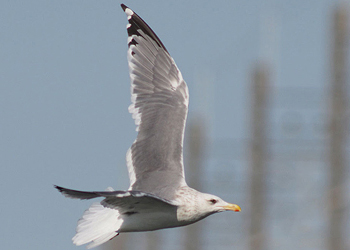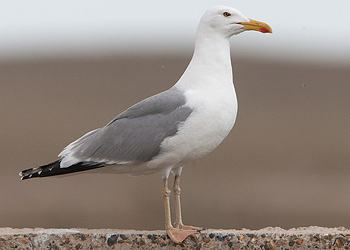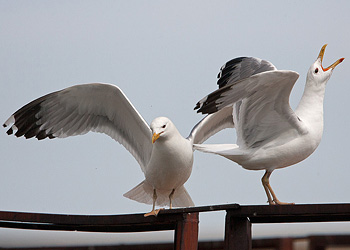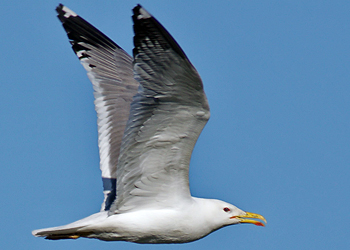 Larus cachinnans
Larus cachinnans
(last update:
Greg Neubauer
Marcin Przymencki
Albert de Jong
Mars Muusse
3cy cachinnans: April
Phenotypic variation and systematics of Mongolian Gull
IN: Dutch Birding 23: 82, 2001 BY: Pierre Yésou
PART 1: INTRO & DISTRIBUTION
PART 2 PHENOTYPIC VARIATION
PART 3: BILL, EYE & LEG COLOUR
BELOW PART 4: DISCUSSION
Discussion
Mantle colour and wing-tip pattern
On the basis of the type specimen collected in north-western Mongolia, Sushkin (1925) described the mantle of mongolicus as being darker than that of cachinnans, a statement repeated by Stepanyan (1990). Dement’ev (1951) described the mantle colour of mongolicus as similar to that of vegae. My research on museum skins showed that some birds of north-western Mongolia are on the darker side of the variation found in mongolicus, a tentative explanation of Sushkin’s description. Many mongolicus, however, are paler than this and their mantle colour overlaps with that of both cachinnans and vegae (see figure 1). Birds of the latter taxon can, however, be paler than any mongolicus, particularly in the northernmost part of the range of birulai (unpublished data from museum study).
The grey inner tongue on P10 was mentioned by Sushkin (1925) but no information was available on the wing-tip pattern of mongolicus, except for Stegmann’s (1934) statement of seven to eight primaries with black and the presence of a subterminal black bar on P10, and complementary figures given by Panov & Monzikov (2000). My reference to a much larger set of birds showed that the inner tongue on P10, although usually pale grey (ie, paler than in vegae, which is in agreement with Sushkin’s original description), is darker in some birds and then resembles the pattern found in vegae and birulai. Also, the number of primaries with black (six to nine) is more variable than previously thought and the presence of a subterminal black bar on P10 is no absolute rule.
Obviously, the larger the number of birds studied, the better the understanding of the phenotypic variation. Our knowledge, first based on small samples (either museum series or migrants of known origin), has strongly increased by studying birds in colonies (see, for instance, Buzun 1993, Filchagov 1993, Liebers & Dierschke 1997, Liebers & Helbig 1999, Panov & Monzikov 2000). This also holds for measurements, the range of which often increases with sample size (mean values are less affected).
Bare-part coloration
The bare-part coloration of mongolicus I established agrees with most previous descriptions in the literature. The vermilion-red orbital ring was mentioned in Sushkin’s (1925) original description. The variability of iris and leg colours is known since Madge (1985). It remained, however, unquantified until Pyzhianov & Tupitchyn (1992) and this study.
Such a large variation in bare-part coloration in one population may be surprising to western birders accustomed to colonies inhabited by uniformly looking Herring L. argentatus, Yellow-legged or Lesser Black-backed Gulls. However, the fact is that highly variable grey or brown pigmentation over the yellow iris occurs in breeding birds of all Asian taxa of the argentatus-cachinnans-fuscus complex, seemingly being the least marked in vegae (Filchagov 1993, Liebers & Dierschke 1997, Liebers & Helbig 1999, Panov & Monzikov 2000, Andrey Filchagov and V. I. Grabovsky pers comm, pers obs). It also occurs, although very rarely leading to grey-looking irides, in michahellis (N Baccetti pers comm). Regarding the variability of leg colour, this is also found in cachinnans (Liebers & Dierschke 1997, V. I. Grabovsky pers comm) and is commonplace in northern Siberia, from north-western Taimyr to the Lena delta at least, over the range of birulai (eg, Yésou & Hirschfeld 1997).
Until Hirschfeld (1992) and Madge (1992), little attention has been paid to the frequency and size of dark bill-markings in adult large gulls. This is the first time that these are described for mongolicus. Such bill-markings are shared, in variable size and proportion, with the Asian taxa of the argentatus-cachinnans-fuscus complex (Filchagov 1993, Liebers & Dierschke 1997, Yésou & Hirschfeld 1997, Panov & Monzikov 2000).
Systematics
Recently proposed systematic arrangements (eg, Devillers & Potvliege 1981, Haffer 1982, Devillers 1983, Stepanyan 1990, del Hoyo et al 1996, Sangster et al 1999) have generally presented mongolicus as a subspecies of cachinnans, in classifications encompassing (almost) all the southern taxa of Palearctic yellow-legged large white-headed gulls under cachinnans. This treatment is based on the supposed continuity in distribution (as given in oversimplified distribution maps like, for instance, the one in Yésou & Hirschfeld 1997), similarity in mantle colour and possibly also in the white head in winter shown by most southern taxa (atlantis, a subspecies of cachinnans according to some of the above-mentioned authors, is dark hooded in winter). This, however, remains a hypothetical classification, pending further research on the relationships between cachinnans and neighbouring taxa (eg, Yésou et al 1994, Sangster et al 1999).
On the basis of the now available information, it is clear that there are marked phenotypic differences between mongolicus and cachinnans, particularly in wing-tip pattern (the number of primaries with black, the grey inner tongue and subterminal black bar on P10; see, for instance, Garner & Quinn (1997) and Jonsson (1998) for a description of the wing-tip of cachinnans) and underwing colour (pale grey in mongolicus and white in cachinnans). Such differences are sufficient to consider mongolicus and cachinnans as different species under the Phylogenetic Species Concept (PSC). Proponents of the Biological Species Concept (BSC) could argue that intergradation remains a possibility in a still undocumented contact area. If intergradation ever occurs, it should in any case be limited by the low density of both mongolicus and cachinnans in the neighbouring part of their respective breeding ranges (Pyzhjanov & Tupitsyn 1994, Pyzhianov 1996, Andrey Filchagov pers comm). Occasional mix-pairing has no taxonomic value, even under the BSC (see, for instance, the occasional argentatus x graellsii or argentatus/graellsii x michahellis pairs in Western Europe; Yésou 1991). Furthermore, a preliminary mitochondrial DNA analysis (Crochet 1998) showed that mongolicus largely differs genetically from cachinnans, thus invalidating the hypothesis of the existence of significant gene flow between the two taxa. In fact, mongolicus is genetically closer to the Siberian taxa heuglini and in particular birulai of Taimyr (Crochet 1998, who had no access to material of eastern birulai and vegae).
Also, although no comparative analysis has been performed to elucidate vocal relationships in Siberian gulls, the vocalizations of mongolicus clearly differ from those of cachinnans (according to observers with a hearing ability better than mine) and seem closer to those heard in Taimyr (Andrey Filchagov pers comm).
Should mongolicus be considered as a full species or should it be considered as a subspecies of vegae, together with birulai? The fact is that these taxa resemble each other although differences have been noted, particularly in wing-tip pattern (the number of primaries with black, the size and colour of the tongue on P10), proportion of birds without a complete subterminal black bar on P10) and in winter-plumage markings.
The ranges of vegae (including birulai) and mongolicus, which breed in the Arctic tundra and at lakes in the steppe belt, respectively, are separated by a more than 1000-km wide taiga belt where no large gulls are known to breed. The breeding environment of mongolicus and vegae nevertheless shows marked similarities, due to the late and cold spring at Lake Baikal. As an illustration of this, the behavioural adaptation to low temperatures shown by fleas parasiting nests of mongolicus at Lake Baikal is otherwise known only from fleas of Arctic and Antarctic seabirds (Guiguen et al 1993). Could then some spring migrants, which regularly stop over at Lake Baikal when en route to Taimyr and possibly western Yakutia (Sergey Pyzhianov pers comm), be attracted by seemingly favourable environmental conditions and stay to breed at Lake Baikal, then leading to some degree of intergradation? This seems, however, unlikely as Arctic birds start to breed 35-45 days later than Lake Baikal birds (Filchagov et al 1992, pers obs) and they are presumably hormonally not in breeding condition when passing through the Lake Baikal area.
In conclusion, species status should be given to mongolicus under both the PSC (diagnostic differences in, for instance, wing-tip pattern and winter-plumage markings) and the BSC (not interbreeding freely to any significant degree). It then appears that the Asian taxa until recently considered as subspecies of cachinnans are now better taken as full species, namely armenicus,
barabensis and mongolicus (Buzun 1993, Filchagov 1993, Liebers & Helbig 1999, Panov & Monzikov 2000, this study), as Panov & Monzikov’s (2000) suggestion that barabensis is a subspecies of heuglini is easily rejected on arguments similar to those I have developed about the relationships between mongolicus and other taxa.
My field and museum work in Russia was part of a co-operation scheme between the Russian Academy of Sciences and my employing structure (ONC-Faune Sauvage, French Ministry of Environment), and my visit to Lake Baikal was arranged in the framework of ornithological expeditions then organized in Siberia by Academician Professor E E Syroechkoysky from the Severtsov Institute in Moscow. I have been friendly welcomed and looked after all around Lake Baikal by Sergey Pyzhianov, who willingly shared his wide knowledge of the birds, the lake and its environment - and his wife Olga. I am much indebted to them. Also, the biologists from various scientific institutions in Irkutsk and Ulan Ude have always welcomed me to their field stations; their company has been appreciated both at work and after it. Thanks to their curator Pavel Tomkovich, I had access to the skin collection in the Moscow Zoological Museum where I benefited from the expert guidance of Andrey Filchagov who also showed me his skin collection and shared long conversations on the systematics and biology of Holarctic large white-headed gulls.
Under the recommendation of V M Loskot, curator at the Zoological Institute of St Petersburg, L V Firsova kindly prepared for me a part of the impressive skin collection held there. The company of Elena Zubakina, the wife of the reputed ornithologist Victor Zubakin, an expert gull student himself, has been most pleasing and helpful during my return trip from Lake Baikal to St Petersburg and Moscow. Sergey Pyzhianov, Andrey Filchagov and E I Kozhurina have greatly helped with the translation of Russian articles.
Lastly, Gerald Oreel invited me to write this article for Dutch Birding after the presentation I gave on the same topic at the 4th International Gull Meeting (organized by Ted Hoogendoorn, Dirk Raes and Pascal Raevel) at Le Portel, Pas-de-Calais, France, on 7-10 October 1999. Many thanks to all of them.
References
See PDF.
 Larus cachinnans 2CY-5CY UKK T-001874 May 2010 - July 2013, Windheim & Deponie Pohlsche Heide - Minden, Germany.
Picture: Armin Deutsch.
Larus cachinnans 2CY-5CY UKK T-001874 May 2010 - July 2013, Windheim & Deponie Pohlsche Heide - Minden, Germany.
Picture: Armin Deutsch. 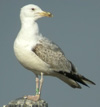 Larus cachinnans 3CY 88P4 April 24 2010, Lubna, Poland. Picture: Michal Rycak.
Larus cachinnans 3CY 88P4 April 24 2010, Lubna, Poland. Picture: Michal Rycak. Larus cachinnans 3CY PKCK March-April 2013, Switzerland. Picture: Christopher Plummer & Julien Torre.
Larus cachinnans 3CY PKCK March-April 2013, Switzerland. Picture: Christopher Plummer & Julien Torre.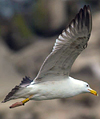 Larus cachinnans 1CY-3CY PKNX December 2012 - November 2014, France & Poland. Picture: Patrick Fontaine, Janusz Wójcicki & Alain Fossé.
Larus cachinnans 1CY-3CY PKNX December 2012 - November 2014, France & Poland. Picture: Patrick Fontaine, Janusz Wójcicki & Alain Fossé.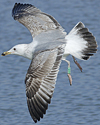 Larus cachinnans (hybrid?) XHHD 3CY, April 02 2017, Katwijk, the Netherlands. Picture: Mars Muusse.
Larus cachinnans (hybrid?) XHHD 3CY, April 02 2017, Katwijk, the Netherlands. Picture: Mars Muusse.  Larus cachinnans 3CY, April 03 2017, Katwijk, the Netherlands.
Larus cachinnans 3CY, April 03 2017, Katwijk, the Netherlands.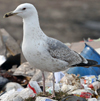 Larus cachinnans 3cy, 08-13 April 2009, Riga, Latvia. Picture: Chris Gibbins.
Larus cachinnans 3cy, 08-13 April 2009, Riga, Latvia. Picture: Chris Gibbins. Larus cachinnans 3cy, 08-13 April 2009, Riga, Latvia. Picture: Chris Gibbins.
Larus cachinnans 3cy, 08-13 April 2009, Riga, Latvia. Picture: Chris Gibbins.